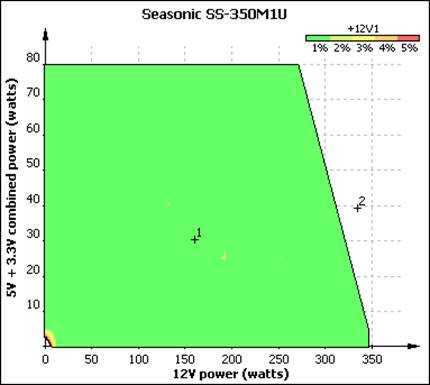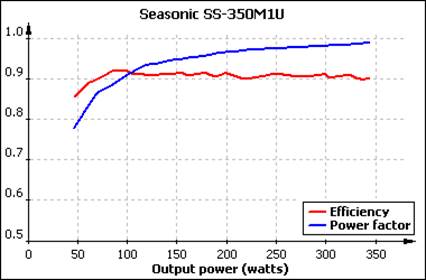Compatible UPS
Working together with our APC SmartUPS SC
620, the SS-300M1U was stable at its full load of 300 watts when powered by the
mains and could switch to the UPS’s batteries at the same load, too.
SS-350M1U was also quite stable at its full
load of 350W when powered by the mains. Even so, it can only be transferred to
the UPS batteries at load up to 315W.
Cross-Load Voltage Stability

The
junior model is quite stable
The junior model is quite stable, keeping
its +12V and +5V voltages within 2% of the required levels. +3.3V voltage is
not lower than 3%.

The
350W model is even better.
The 350W model is even better in this test.
Its +12V voltage is almost always within 1% of the required level. The other
voltages are comparable to those of the 300W model.
Output Voltage Ripple
The PSUs are similar to each other in terms
of high-frequency output voltage ripple.

The
PSUs are similar to each other in terms of high-frequency output voltage
ripple.

Both
PSUs meet the industry standard requirements
Both PSUs meet the industry standard
requirements here.
It’s different at the double mains
frequency:

It’s
different at the double mains frequency
The 300W unit has some voltage ripple on
the +12V rail only, but it is not strong.

The
higher-wattage unit is close to the permissible limits
The higher-wattage unit is close to the
permissible limits on the +5V and +12V rails. The voltage ripple is weak on the
+3.3V rail.
Temperature and noise

Being
cooled by a 40x40x20mm ADDA AD0412XB-C71GP fan
Both PSus are cooled by a 40x40x20mm ADDA
AD0412XB-C71GP fan We can't find its specs but in its latest model,
AD0412XB-C73GP(P), has a rated speed of 10,000 RPM at 0.24 amperes whereas the
AD0412XB-C71GP consumes up to 0.3 amperes.
Unfortunately, we can't evaluate fan's
speed with our optical tachometer due to the configuration of the vent grid and
the small size of the fan itself, so we have to limit ourselves to our
subjective impressions.

The
fan does not actually work at all at loads up to 140-150W
The fan does not actually work at all at
loads up to 140-150W as described on the nearby sticker. Therefore, it starts
up at a quiet speed, becomes audible at loads of 250W, and is really noisy at
300W. The 350W model surely is noisier at full loads than any other ATX PSUs
that we tested recently in the laboratory.
Though we can not see this as a serious
drawback, because such a high load can only take place in the compact gaming
computer with discrete graphics.
Efficiency and power factor

SS-300M1U
was 87.6%, 91.9% and 91.5% efficient at reference loads
SS-300M1U was 87.6%, 91.9% and 91.5%
efficient at reference loads 20%, 50% and 100%, respectively. The peak
efficiency of 92.7% was observed at a load of 141W.

As
for SS-350M1U, it was 90.1%, 91.5% and 90.4% efficient
As for SS-350M1U, it was 90.1%, 91.5% and
90.4% efficient at reference load 20%, 50% and 100%, respectively. The peak
efficiency of 92.2% was observed at a load of 100W.
The PSUs meet the 80 PLUS Gold requirements
but the higher-wattage model is inferior throughout the entire load range
except at low loads (where our measurement accuracy is lower, too).
The power factor is up to 99% with both
PSUs at high loads, as promised by the manufacturers.
Standby source

The
standby source works blamelessly
The standby source works blamelessly in
each model, so we only show you the senior model's graph.